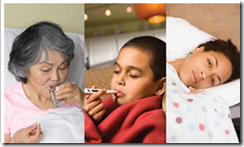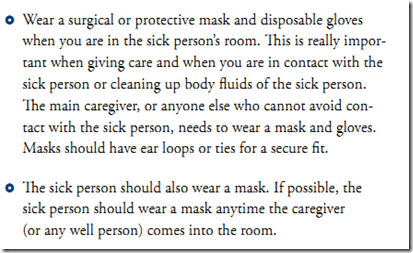WHO: Homecare Advice For Mild MERS-CoV Cases

Photo Credit CDC
# 7551
Today The World Health Organization released a brief (7 page) document advising on how best to care for `mild? MERS-CoV cases at home in the event that hospital care is either not feasible, or not desired by the patient.
Whether we are talking about a greater outbreak of MERS-CoV, or the spread of pandemic flu, the reality is during a genuine epidemic hospitals will quickly reach their capacity, and will be able to admit only the `sickest of the sick?.
Anticipating this, a number of state and federal agencies have prepared Home Care Guides for use during a pandemic.
One of the most comprehensive, comes from the Santa Clara County Health Department, California and is available on CIDRAP?s Public Health Practices website.
Home Care Guide: Providing Care at Home During Pandemic Flu
Home Care Guide (Vietnamese) Download pdf, 551 KB
Home Care Guide (Spanish)Download pdf, 203 KB
Home Care GuideDownload pdf, 6 MB
The Home Care Guide provides the public with a comprehensive description of how to care for sick family members at home during a pandemic. It includes lists of emergency supplies, guidelines on how to limit the spread of disease at home, instructions on how to take care of sick household members safely and effectively and basic information about pandemic flu. This guide was created prior to the emergence of novel H1N1 flu virus in 2009. Therefore, the fact sheets located under the attachments tab in the guide contain some generalized information about pandemics, as well as information about avian influenza that may need to be updated. The guide is available in English, Spanish, and Vietnamese.

Part of the advice in the WHO MERS guidelines, and the Pandemic Flu Homecare guides, is to use facemasks to reduce the spread of infection. This from the Santa Clara County guide:

We obviously don?t know if another pandemic is in the offing anytime soon, but it is always prudent to be prepared. Besides, most of the information provided in these flu brochures is applicable for dealing with seasonal flu at home, as well.
Posted by Michael Coston at <a class="timestamp-link" href="http://afludiary.blogspot.com/2013/08/who-homecare-advice-for-mild-mers-cov.html" rel="bookmark" title="permanent link"><abbr class="published" title="2013-08-08T08:13:00-04:00">8:13 AM</abbr>

Photo Credit CDC
# 7551
Today The World Health Organization released a brief (7 page) document advising on how best to care for `mild? MERS-CoV cases at home in the event that hospital care is either not feasible, or not desired by the patient.
We?ve already seen a small number of mild cases managed successfully at home, and should this virus ever begin to spread widely, the home care option will likely become even more common.
While acknowledging that hospitalization ? at least at this stage of the spread of the virus ? is probably preferable for all symptomatic cases, this document recognizes there may be some instances where home care is a reasonable option. They write: Home care for patients with MERS-CoV infection presenting with mild symptoms
In view of the currently limited knowledge of the disease and its transmission, it may be prudent to hospitalize confirmed and probable (2) symptomatic cases of the MERS-CoV infection. This would ensure both safety and quality of healthcare and public health security.
However, for several possible reasons, including situations when inpatient care is unavailable or
unsafe, or in a case of informed refusal of hospitalization, alternative settings 3 for health care provision may need to be considered.
Depending on the local circumstances and resource availability, symptomatic contacts with milder symptoms 4 and without underlying conditions that put the patient at increased risk of developing complications, may be cared for in the home environment.
The same principle of care in the home environment applies to symptomatic patients not requiring or no longer requiring hospitalization. This decision requires careful clinical judgment and should be informed by assessing the safety of the patient?s home environment 5.
I?ve included some excerpts, but you?ll want to download and read the entire document.In view of the currently limited knowledge of the disease and its transmission, it may be prudent to hospitalize confirmed and probable (2) symptomatic cases of the MERS-CoV infection. This would ensure both safety and quality of healthcare and public health security.
However, for several possible reasons, including situations when inpatient care is unavailable or
unsafe, or in a case of informed refusal of hospitalization, alternative settings 3 for health care provision may need to be considered.
Depending on the local circumstances and resource availability, symptomatic contacts with milder symptoms 4 and without underlying conditions that put the patient at increased risk of developing complications, may be cared for in the home environment.
The same principle of care in the home environment applies to symptomatic patients not requiring or no longer requiring hospitalization. This decision requires careful clinical judgment and should be informed by assessing the safety of the patient?s home environment 5.
Rapid advice note on home care for patients with Middle East respiratory syndrome coronavirus (MERS-CoV) infection presenting with mild symptoms and management of contacts
08 August 2013
(EXCERPT)
Because of the possibility of rapid progression to the acute respiratory distress syndrome (ARDS) and other severe, life-threatening complications, even otherwise healthy, symptomatic contacts or probable cases should be placed under close medical observation when receiving care at home.
The patients and the household members should be educated on personal hygiene and basic infection prevention and control measures, and they should adhere to the following recommendations:
(Continue . . . )
08 August 2013
(EXCERPT)
Because of the possibility of rapid progression to the acute respiratory distress syndrome (ARDS) and other severe, life-threatening complications, even otherwise healthy, symptomatic contacts or probable cases should be placed under close medical observation when receiving care at home.
The patients and the household members should be educated on personal hygiene and basic infection prevention and control measures, and they should adhere to the following recommendations:
- Limit contact with the ill person as much as possible. The household members should stay in a different room or, if that is not possible, maintain a distance of at least one metre from the ill person (e.g. sleep in a separate bed).
- Ensure that anyone who is at increased risk of severe disease does not care for the ill person or come into close contact with the ill person. The current groups considered at increased risk for the MERS-CoV infection nclude those with chronic heart, lung or kidney conditions; diabetes; immunosuppression; blood disease; and older adults. If contact with the ill person
cannot be avoided by those with an increased risk of severe disease, alternative housing should be considered. - Perform hand hygiene (12) following all contact with the ill person or his/her immediate environment. Hand hygiene should also be performed before and after preparing food, before eating, after using the toilet, and whenever hands look dirty. Perform hand hygiene using soap and water. If hands are not visibly soiled, alcohol-based hand rub can be used. Assistance for the ill person to perform regular hand hygiene may be provided as needed. Paper towels to dry hands are desirable; if they are not available, use dedicated cloth towels and replace them when they become wet.
- Respiratory hygiene should be practiced by all, especially the ill person. Respiratory hygiene
refers to covering the mouth and nose during coughing or sneezing using medical masks, cloth masks, tissues or flexed elbow, followed by hand hygiene. - Discard materials used to cover the mouth or nose, or clean them appropriately after use (e.g. wash handkerchiefs using regular soap or detergent and water).
- The caregiver should wear a medical mask fitted tightly to the face when in the same room with the ill person. Masks should not be touched or handled during use. If the mask gets wet or dirty with secretions, it must be changed immediately. Discard the mask after use and perform hand hygiene after removal of the mask.
(Continue . . . )
Whether we are talking about a greater outbreak of MERS-CoV, or the spread of pandemic flu, the reality is during a genuine epidemic hospitals will quickly reach their capacity, and will be able to admit only the `sickest of the sick?.
Home care will become the norm, not the exception.
Flu.gov warns of Overloaded Health Care Systems during any severe influenza pandemic, writing:- Most people have little or no immunity to a pandemic virus. Infection and illness rates soar. A substantial percentage of the world?s population will require some form of medical care.
- Nations are unlikely to have the staff, facilities, equipment, and hospital beds needed to cope with the number of people who get the pandemic flu.
Anticipating this, a number of state and federal agencies have prepared Home Care Guides for use during a pandemic.
One of the most comprehensive, comes from the Santa Clara County Health Department, California and is available on CIDRAP?s Public Health Practices website.
Home Care Guide: Providing Care at Home During Pandemic Flu
Home Care Guide (Vietnamese) Download pdf, 551 KB
Home Care Guide (Spanish)Download pdf, 203 KB
Home Care GuideDownload pdf, 6 MB
The Home Care Guide provides the public with a comprehensive description of how to care for sick family members at home during a pandemic. It includes lists of emergency supplies, guidelines on how to limit the spread of disease at home, instructions on how to take care of sick household members safely and effectively and basic information about pandemic flu. This guide was created prior to the emergence of novel H1N1 flu virus in 2009. Therefore, the fact sheets located under the attachments tab in the guide contain some generalized information about pandemics, as well as information about avian influenza that may need to be updated. The guide is available in English, Spanish, and Vietnamese.


We obviously don?t know if another pandemic is in the offing anytime soon, but it is always prudent to be prepared. Besides, most of the information provided in these flu brochures is applicable for dealing with seasonal flu at home, as well.
So you may want to download one of these guides today, and think about what supplies you may want to have on hand that are available now, but that may be in short supply during an outbreak.
For more on the relative merits of different types of facemasks, you may also want to revisit The Great Mask Debate Revisited.Posted by Michael Coston at <a class="timestamp-link" href="http://afludiary.blogspot.com/2013/08/who-homecare-advice-for-mild-mers-cov.html" rel="bookmark" title="permanent link"><abbr class="published" title="2013-08-08T08:13:00-04:00">8:13 AM</abbr>
Comment